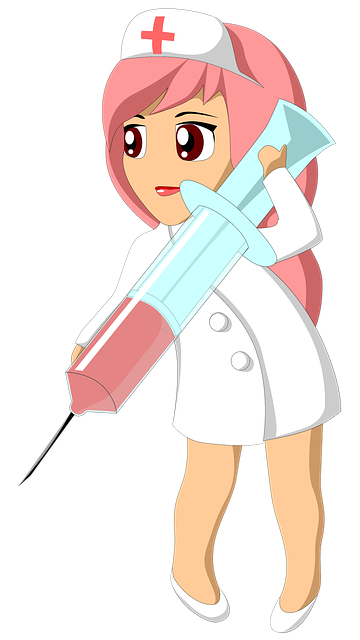Post-injection flare-ups are common after using corticosteroids for joint pain relief, caused by the body's immune response to foreign substances. Triggers like physical activity, extreme temperatures, or emotional stress can exacerbate these reactions. Corticosteroid injections effectively reduce inflammation and swelling in joints affected by arthritis or tendinitis, providing significant pain relief. To manage temporary discomfort, patients can stay hydrated, apply ice packs, take over-the-counter pain relievers, perform gentle movements, use relaxation techniques like deep breathing, meditation, or yoga, and adjust medication dosages under healthcare guidance. If symptoms persist or worsen after a few days, medical attention is necessary as corticosteroids carry potential side effects, including rapid breathing, chest pain, severe nausea, or sudden mental state changes.
In today’s medical landscape, corticosteroid injections are a popular solution for managing severe joint pain. However, post-injection flare-ups and temporary discomfort are common side effects that can significantly impact patient experience. This article delves into understanding the causes and triggers of these flare-ups, exploring the mechanism of action behind corticosteroid injections for joint pain relief. We also offer effective strategies to manage temporary discomfort and guide readers on recognizing when to seek medical attention for potential serious side effects.
Understanding Post-Injection Flare-ups: Causes and Triggers
Post-injection flare-ups are a common occurrence, especially when using corticosteroids for joint pain relief. These flare-ups can be attributed to various factors that trigger an inflammatory response in the body. One of the primary causes is the natural healing process itself. After an injection, the body’s immune system might recognize the medication as a foreign substance, leading to localized inflammation as it attempts to clear the area. This reaction can cause temporary discomfort and swelling.
Additionally, certain activities or environmental factors can act as triggers. For instance, physical exertion, exposure to extreme temperatures, or even emotional stress may exacerbate post-injection symptoms. Understanding these triggers is essential for individuals seeking joint pain relief through corticosteroid injections. By recognizing the patterns and taking preventive measures, one can effectively manage flare-ups and promote faster recovery.
Corticosteroid Injection: Mechanism of Action for Joint Pain Relief
Corticosteroid injections are a common treatment for managing severe joint pain, particularly in conditions like arthritis or tendinitis. These powerful anti-inflammatory drugs work by reducing swelling and inflammation inside the joint, which in turn provides immediate and significant joint pain relief. When injected directly into the affected area, corticosteroids can quickly target and alleviate discomfort, allowing patients to regain mobility and ease their suffering.
The mechanism of action involves several key processes. Corticosteroids inhibit the production of certain chemicals that cause inflammation, such as prostaglandins. They also suppress immune cells that may be contributing to the inflammatory response. This dual action helps to reduce heat, swelling, and pain in the joint, offering patients much-needed relief from chronic or acute joint pain.
Effective Strategies to Manage Temporary Discomfort After Injections
Managing temporary discomfort after injections, such as those involving corticosteroids for joint pain relief, requires a multi-faceted approach. First, staying hydrated and applying ice packs to the injection site can significantly reduce swelling and pain. Over-the-counter pain relievers like ibuprofen or acetaminophen can also help manage acute discomfort. Additionally, gentle movement and light stretching exercises can improve circulation and speed up recovery.
For more persistent or severe flare-ups, consider incorporating relaxation techniques such as deep breathing, meditation, or yoga into your routine. These practices have been shown to decrease stress levels, which in turn reduces inflammation throughout the body. Furthermore, consulting with a healthcare professional about adjusting medication dosages or exploring alternative treatments can provide tailored solutions for managing post-injection discomfort effectively.
When to Seek Medical Attention: Recognizing Serious Side Effects
If you experience severe or persistent symptoms that don’t improve after a few days, it’s crucial to seek medical attention. While joint pain relief with corticosteroids can be highly effective for managing post-injection flare-ups, there are some serious side effects to watch out for. Signs like rapid breathing, chest pain, severe nausea, or sudden changes in your mental state warrant immediate care. These could indicate a rare but critical reaction to the injection or corticosteroid treatment.
Remember that while temporary discomfort is common, persistent or escalating symptoms are not normal. Your healthcare provider can assess whether these issues require adjustments to your treatment plan or if further intervention is necessary. Actively monitoring your body and seeking prompt medical advice can help ensure safe and effective recovery from post-injection flare-ups.
Post-injection flare-ups and temporary discomfort are common, but manageable. By understanding the causes, such as inflammation and irritant triggers, and employing effective strategies like rest, ice, compression, and elevation (RICE), individuals can find significant joint pain relief with corticosteroid injections. Knowing when to seek medical attention for serious side effects ensures prompt treatment and prevents complications. With proper care, patients can experience lasting relief while minimizing discomfort during the recovery process.
